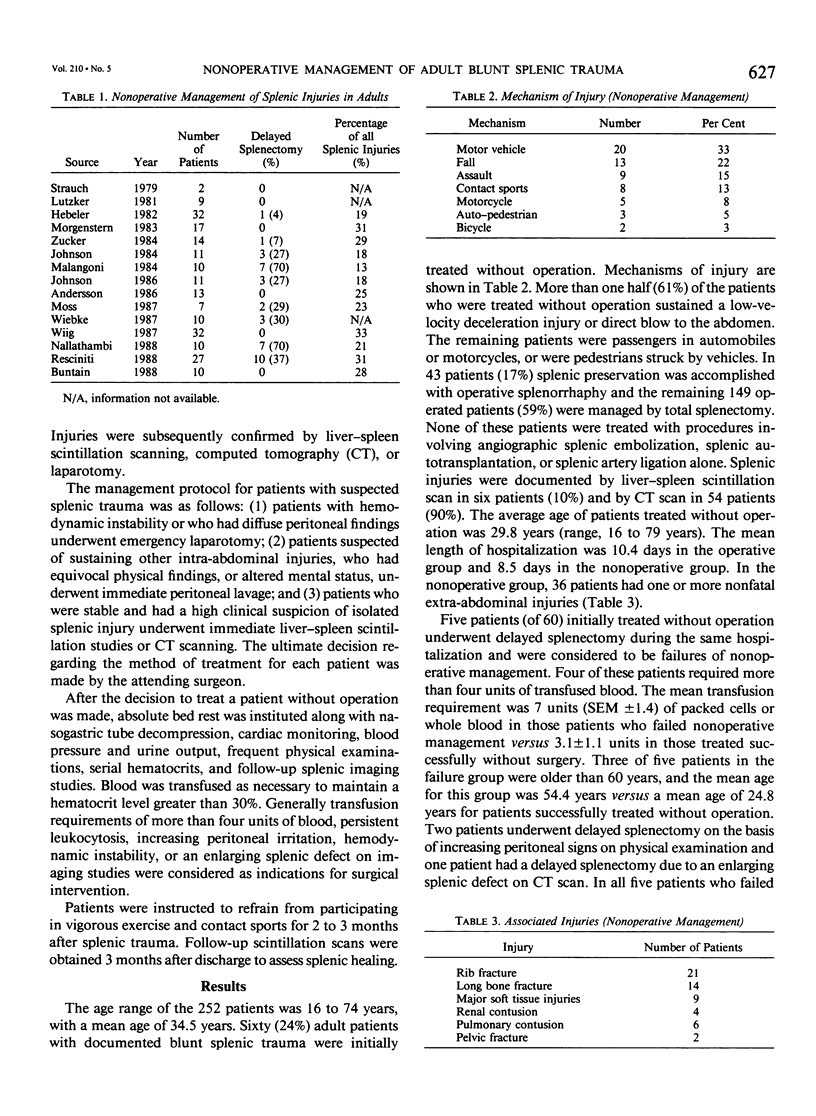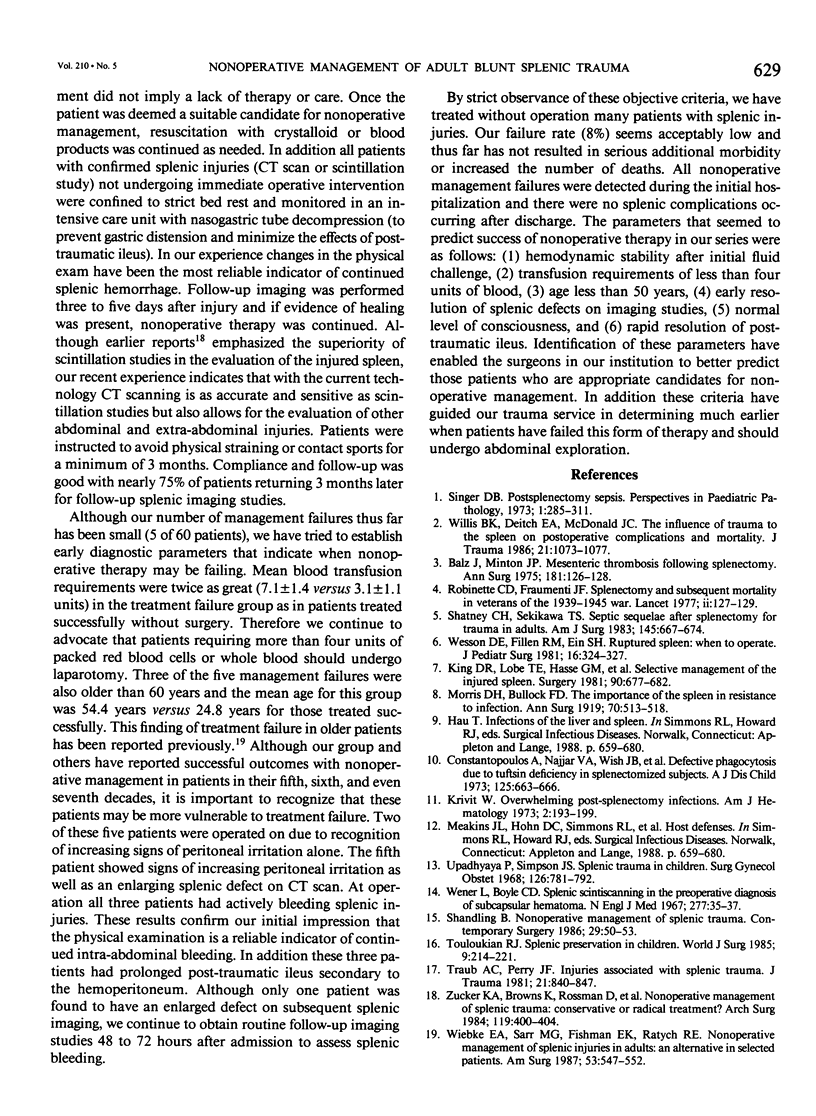Abstract
Nonoperative management of blunt splenic trauma in adults is controversial despite numerous reports advocating this mode of therapy. Blunt splenic trauma is frequently managed without operation at our institution and, to define criteria that may predict a successful outcome, a retrospective review (1980 to 1988) of all adult splenic injuries was undertaken. Splenic injuries were documented by scintillation studies, CAT scanning, or at laparotomy. Sixty of 252 (24%) splenic injuries were initially treated without operation, which included bed rest, ICU monitoring, frequent physical exams, nasogastric tube, serial hematocrits, and follow-up splenic imaging. Five patients (5 of 60) failed nonoperative management and required interval laparotomy. Reasons for failure included blood loss greater than four units, enlarging splenic defect, or increasing peritoneal signs. Parameters predicting a successful outcome were localized trauma to the left flank or abdomen, hemodynamic stability, transfusion requirements less than four units, rapid return of GI function, age less than 60 years, and early resolution of splenic defects on imaging studies. No morbidity or deaths resulted from delayed operative intervention. In carefully selected adult patients, blunt splenic trauma may be successfully managed without operation.
Full text
PDF



Selected References
These references are in PubMed. This may not be the complete list of references from this article.
- Balz J., Minton J. P. Mesenteric thrombosis following splenectomy. Ann Surg. 1975 Jan;181(1):126–128. doi: 10.1097/00000658-197501000-00026. [DOI] [PMC free article] [PubMed] [Google Scholar]
- Constantopoulos A., Najjar V. A., Wish J. B., Necheles T. H., Stolbach L. L. Defective phagocytosis due to tuftsin deficiency in splenectomized subjects. Am J Dis Child. 1973 May;125(5):663–665. doi: 10.1001/archpedi.1973.04160050017004. [DOI] [PubMed] [Google Scholar]
- King D. R., Lobe T. E., Haase G. M., Boles E. T., Jr Selective management of injured spleen. Surgery. 1981 Oct;90(4):677–682. [PubMed] [Google Scholar]
- Morris D. H., Bullock F. D. THE IMPORTANCE OF THE SPLEEN IN RESISTANCE TO INFECTION. Ann Surg. 1919 Nov;70(5):513–521. doi: 10.1097/00000658-191911000-00001. [DOI] [PMC free article] [PubMed] [Google Scholar]
- Robinette C. D., Fraumeni J. F., Jr Splenectomy and subsequent mortality in veterans of the 1939-45 war. Lancet. 1977 Jul 16;2(8029):127–129. doi: 10.1016/s0140-6736(77)90132-5. [DOI] [PubMed] [Google Scholar]
- Sekikawa T., Shatney C. H. Septic sequelae after splenectomy for trauma in adults. Am J Surg. 1983 May;145(5):667–673. doi: 10.1016/0002-9610(83)90118-6. [DOI] [PubMed] [Google Scholar]
- Singer D. B. Postsplenectomy sepsis. Perspect Pediatr Pathol. 1973;1:285–311. [PubMed] [Google Scholar]
- Touloukian R. J. Splenic preservation in children. World J Surg. 1985 Apr;9(2):214–221. doi: 10.1007/BF01656314. [DOI] [PubMed] [Google Scholar]
- Traub A. C., Perry J. F., Jr Injuries associated with splenic trauma. J Trauma. 1981 Oct;21(10):840–847. doi: 10.1097/00005373-198110000-00003. [DOI] [PubMed] [Google Scholar]
- Upadhyaya P., Simpson J. S. Splenic trauma in children. Surg Gynecol Obstet. 1968 Apr;126(4):781–790. [PubMed] [Google Scholar]
- Wener L., Boyle C. D. Splenic scintiscanning in the preoperative diagnosis of subcapsular hematoma. N Engl J Med. 1967 Jul 6;277(1):35–37. doi: 10.1056/NEJM196707062770109. [DOI] [PubMed] [Google Scholar]
- Wesson D. E., Filler R. M., Ein S. H., Shandling B., Simpson J. S., Stephens C. A. Ruptured spleen--when to operate? J Pediatr Surg. 1981 Jun;16(3):324–326. doi: 10.1016/s0022-3468(81)80689-6. [DOI] [PubMed] [Google Scholar]
- Wiebke E. A., Sarr M. G., Fishman E. K., Ratych R. E. Nonoperative management of splenic injuries in adults: an alternative in selected patients. Am Surg. 1987 Oct;53(10):547–552. [PubMed] [Google Scholar]
- Willis B. K., Deitch E. A., McDonald J. C. The influence of trauma to the spleen on postoperative complications and mortality. J Trauma. 1986 Dec;26(12):1073–1076. doi: 10.1097/00005373-198612000-00002. [DOI] [PubMed] [Google Scholar]
- Zucker K., Browns K., Rossman D., Hemingway D., Saik R. Nonoperative management of splenic trauma. Conservative or radical treatment? Arch Surg. 1984 Apr;119(4):400–404. doi: 10.1001/archsurg.1984.01390160036008. [DOI] [PubMed] [Google Scholar]


